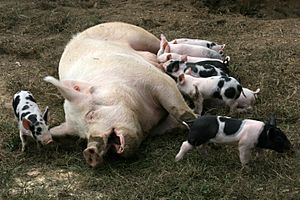Lactose intolerance facts for kids
Lactose intolerance means a person has trouble digesting milk and milk products like cheese or yogurt. All mammals drink their mother's milk when they are babies. But as they grow, most mammals stop drinking milk. This process is called weaning.
Lactose is a type of sugar found in milk. It's a "double sugar" molecule. To digest it, your body needs to break it down into two simpler sugars: glucose and galactose.
Your body uses a special helper called an enzyme called lactase to break down lactose. People with lactose intolerance either don't make enough lactase or don't make any at all. This means they can't properly digest the lactose in milk.
About 75% of people around the world start to lose their ability to digest lactose as they become adults. This is more common in some parts of the world, like Africa and Asia, where over 90% of people might be lactose intolerant. In northern Europe, it's much less common, affecting about 5% of people. There is no cure for lactose intolerance. People who have it need to choose foods and drinks with very little lactose. Luckily, there are many milk substitutes available.
When milk isn't digested properly, it can ferment in the small intestine. This can cause tummy problems. It's important to know that lactose intolerance is different from a milk allergy. A milk allergy is when your immune system reacts to proteins in milk, which is a more serious condition.
Contents
Why Some People Can Digest Milk as Adults
Most baby mammals drink their mother's milk. Then, as they get older, their bodies stop making the lactase enzyme. This means they can no longer digest milk.
Humans are a bit different. Some people continue to make lactase even as adults, while others do not. This is due to a small difference in their genes.
The ability to digest lactose into adulthood is called 'lactase persistence'. This trait became very helpful after humans started animal husbandry, which means keeping animals like cows for their milk.
Before people started farming animals, most Hunter-gatherers were lactose intolerant. Many modern groups of people are still lactose intolerant today. However, many European populations are lactose tolerant. This might be because milk has been a big part of the European diet for a long time. People who could digest milk had more food options, which helped them survive better, especially during tough times.
How Genes Affect Lactose Digestion
A small change, called a mutation, on chromosome 2 in some people stops their bodies from turning off lactase production. This allows them to keep drinking fresh milk and eating other dairy products throughout their lives.
This ability to digest milk as an adult seems to be a recent adaptation in human history. It developed in both northern Europe and east Africa in groups of people who traditionally raised animals for milk. If you have the gene for lactase persistence, it's a dominant trait. This means that lactose intolerance is a recessive trait.
Studies of human genetics show that the oldest mutations linked to lactase persistence became common only in the last 10,000 years. Because of this, lactase persistence is often used as an example of recent human evolution. Since lactase persistence is genetic, but raising animals is a cultural practice, this is an example of genes and culture changing together.
Related pages
Images for kids
See also
 In Spanish: Intolerancia a la lactosa para niños
In Spanish: Intolerancia a la lactosa para niños



